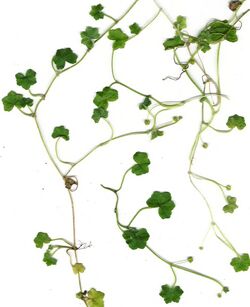Biology:Hydrocotyle
| Hydrocotyle | |
|---|---|

| |
| Hydrocotyle bowlesioides | |
| Scientific classification | |
| Kingdom: | Plantae |
| Clade: | Tracheophytes |
| Clade: | Angiosperms |
| Clade: | Eudicots |
| Clade: | Asterids |
| Order: | Apiales |
| Family: | Araliaceae |
| Subfamily: | Hydrocotyloideae |
| Genus: | Hydrocotyle L.[1][2][3] |
| Synonyms[4] | |
| |
Hydrocotyle, also called floating pennywort,[5] water pennywort,[6] Indian pennywort, dollar weed, marsh penny, thick-leaved pennywort and white rot,[7] is a genus of prostrate, perennial[8] aquatic or semi-aquatic plants formerly classified in the family Apiaceae, now in the family Araliaceae.[3]
Description
Water pennyworts, Hydrocotyles, are very common.[clarification needed] They have long creeping stems that often form dense mats, often in and near ponds, lakes, rivers, and marshes,[6] and some species in coastal areas by the sea.[9][10]
- Leaves
- Simple, with small leafy outgrowth at the base, kidney shaped to round. Leaf edges are scalloped. The leaf surfaces of Hydrocotyle are prime grounds for oviposition of many butterfly species, such as Anartia fatima.
- Flowers
- Flower clusters are simple and flat-topped or rounded. Involucral bracts at the base of each flower. Indistinct sepals.
- Fruits and reproduction
- Elliptical to round with thin ridges and no oil tubes (vitta) which is characteristic in the fruit of umbelliferous plants.[8]
- The prostrate plants reproduce by seed and by sending roots from stem nodes.[11]
Selected species
The genus Hydrocotyle has between 75 and 100 species[12] that grow in tropical and temperate regions worldwide.[8] A few species have entered the world of cultivated ornamental aquatics.[13] A list of selected species:[1][2][3][12][14][15][16]
- Hydrocotyle americana L. — American marshpennywort
- Hydrocotyle asiatica L. is now correctly known as Centella asiatica
- Hydrocotyle batrachium Hance
- Hydrocotyle benguetensis Elm.
- Hydrocotyle bonariensis Lam. — largeleaf pennywort
- Hydrocotyle bowlesioides Mathias & Constance — largeleaf marshpennywort
- Hydrocotyle calcicola
- Hydrocotyle dichondroides Makino
- Hydrocotyle dielsiana
- Hydrocotyle heteromeria — waxweed
- Hydrocotyle hexagona
- Hydrocotyle himalaica
- Hydrocotyle hirsuta Sw. — yerba de clavo
- Hydrocotyle hirta
- Hydrocotyle hitchcockii
- Hydrocotyle hookeri
- Hydrocotyle hydrophila - endemic to New Zealand[17]
- Hydrocotyle javanica Thunb.
- Hydrocotyle keelungensis Liu, Chao & Chuang
- Hydrocotyle leucocephala Cham. & Schltdl. — Brazilian pennywort
- Hydrocotyle mannii Hook.f.
- Hydrocotyle microphylla A.Cunn.
- Hydrocotyle moschata G. Forst. — musky marshpennywort
- Hydrocotyle nepalensis Hook.
- Hydrocotyle novae-zelandiae DC.
- Hydrocotyle phoenix A.J. Perkins — fire pennywort
- Hydrocotyle prolifera Kellogg — whorled marshpennywort
- Hydrocotyle pseudoconferta
- Hydrocotyle pusilla A. Rich. — tropical marshpennywort
- Hydrocotyle ramiflora
- Hydrocotyle ranunculoides L. f. — floating marshpennywort, floating marshpennywort, floating pennyroyal
- Hydrocotyle salwinica
- Hydrocotyle setulosa Hayata
- Hydrocotyle sibthorpioides Lam. — lawn marshpennywort
- Hydrocotyle tambalomaensis
- Hydrocotyle tripartita
- Hydrocotyle umbellata L. — manyflower marshpennywort, umbrella pennyroyal
- Hydrocotyle verticillata Thunb. — whorled marshpennywort, whorled marshpennywort, whorled pennyroyal
- Hydrocotyle vulgaris L. — marsh pennywort, common pennywort
- Hydrocotyle wilfordii
- Hydrocotyle wilsonii
- Hydrocotyle yanghuangensis
Distribution
Hydrocotyleae grow in wet and damp places in the tropics and the temperate zones.[8]
Fossil record
One fossil fruit of a Hydrocotyle sp. has been extracted from borehole samples of the Middle Miocene fresh water deposits in Nowy Sacz Basin, West Carpathians, Poland .[18]
References
- ↑ 1.0 1.1 "Hydrocotyle L.". African Plants Database. South African National Biodiversity Institute, the Conservatoire et Jardin botaniques de la Ville de Genève and Tela Botanica.. http://www.ville-ge.ch/cjb/bd/africa/genre.php?langue=an&id=2141.
- ↑ 2.0 2.1 Natural Resources Conservation Service (NRCS). "Classification for Kingdom Plantae Down to Genus Hydrocotyle L.". The PLANTS Database. United States Department of Agriculture. http://plants.usda.gov/java/ClassificationServlet?source=profile&symbol=HYDRO2&display=31.
- ↑ 3.0 3.1 3.2 Germplasm Resources Information Network (GRIN) (2006-04-02). "Genus: Hydrocotyle L.". Taxonomy for Plants. USDA, ARS, National Genetic Resources Program, National Germplasm Resources Laboratory, Beltsville, Maryland. http://www.ars-grin.gov/cgi-bin/npgs/html/genus.pl?5898.
- ↑ "Hydrocotyle Tourn. ex L..". Plants of the World Online. Royal Botanic Gardens, Kew. http://www.plantsoftheworldonline.org/taxon/urn:lsid:ipni.org:names::40115-1.[|permanent dead link|dead link}}]
- ↑ "Floating pennywort". Invasive Species. 2021. https://www.invasive-species.org/species/floating-pennywort/.
- ↑ 6.0 6.1 University of Florida Herbarium (2005). "Hydrocotyle species". Aquatic, Wetland and Invasive Plant Particulars and Photographs. University of Florida, Center for Aquatic and Invasive Plants. http://plants.ifas.ufl.edu/hydrpic.html.
- ↑ M. Grieve (1931). "Hydrocotyle". A Modern Herbal. © Copyright Protected 1995-2008 Botanical.com. http://www.botanical.com/botanical/mgmh/h/hydcol46.html.
- ↑ 8.0 8.1 8.2 8.3 Flora of China. "Hydrocotyle Linn.". Family List. http://www.efloras.org/florataxon.aspx?flora_id=5&taxon_id=115990.
- ↑ Aluka. "Hydrocotyle bonariensis Lam. [family UMBELLIFERAE"]. African Plants. Ithaka Harbors, Inc. http://www.aluka.org/action/showCompilationPage?doi=10.5555/AL.AP.COMPILATION.PLANT-NAME-SPECIES.HYDROCOTYLE.BONARIENSIS.
- ↑ Klein, Alecsandro Schardosim; Citadini-Zanette, Vanilde; dos Santos, Robson (September 2007). "Florística e estrutura comunitária de restinga herbácea no município de Araranguá, Santa Catarina" (in pt). Biotemas 20 (3): 15–26. https://periodicos.ufsc.br/index.php/biotemas/article/view/20663/18823.
- ↑ Watson, Mark F.. "Hydrocotyle L". Flora of Bhutan. http://rbg-web2.rbge.org.uk/URC/bhutanumbels/Hydrocotyle.htm.
- ↑ 12.0 12.1 Flora of China. "1. Hydrocotyle Linnaeus". Family List 14. http://www.efloras.org/florataxon.aspx?flora_id=2&taxon_id=115990. Retrieved 2008-04-25.
- ↑ "Pennywort, Genus Hydrocotyle". The Aquarium Gardener Series. http://www.wetwebmedia.com/PlantedTksSubWebIndex/hydrocotyle.htm.
- ↑ Taiwan Plant Names. "Hydrocotyle Linn". Family List III. http://www.efloras.org/florataxon.aspx?flora_id=101&taxon_id=115990. Retrieved 2008-04-25.
- ↑ Madagascar Catalog. "Hydrocotyle L.". Genus Page. http://www.efloras.org/florataxon.aspx?flora_id=12&taxon_id=115990.
- ↑ "hydrocotyle". New Zealand Weeds. Massey University: Institute of Natural Resources. http://weeds.massey.ac.nz/weeds.asp?pid=99&sf=common.
- ↑ "Hydrocotyle hydrophila | New Zealand Plant Conservation Network". http://nzpcn.org.nz/flora_details.aspx?ID=828.
- ↑ Łańcucka-Środoniowa M.: Macroscopic plant remains from the freshwater Miocene of the Nowy Sącz Basin (West Carpathians, Poland) [Szczątki makroskopowe roślin z miocenu słodkowodnego Kotliny Sądeckiej (Karpaty Zachodnie, Polska)]. Acta Palaeobotanica 1979 20 (1): 3-117.
External links
- "Hydrocotyle". Integrated Taxonomic Information System. https://www.itis.gov/servlet/SingleRpt/SingleRpt?search_topic=TSN&search_value=29512. Retrieved 25 April 2008.
- Lamarck, Jean Baptiste Pierre Antoine de Monet de (1783–1808). "HYD". Encyclopédie méthodique: botanique /Par m. le chevalier de Lamarck.. Vol. 3. QK7.L36 1783-1808. http://www.botanicus.org/bibliography/b11774435.
Wikidata ☰ Q158200 entry
 |



